Study of Molding and Drying Characteristics of Compressed Municipal Sludge-Corn Stalk Fuel Pellets
Abstract
1. Introduction
2. Materials and Methods
2.1. Suppression of Shaped Sludge Fuel Pellets
2.1.1. Electro-Osmotic Sludge Particles
- A certain amount of sludge was sent to the electro-osmotic dewatering equipment through the sludge hopper, and the sludge was evenly arranged on the filter screen through the conveyor belt. When the electro-osmosis dehydration equipment was working, the anode pressure was 0.3 MPa and the voltage was 16 V. We recorded the electro-osmosis dehydration experiment time with a stopwatch, and then repeatedly measured the sludge moisture content until it met the experimental requirements (moisture content 60–65%);
- The electro-osmotic dewatering sludge was ground. The next step was that the ground electro-osmotic sludge particles were sieved into 20 mesh, 40 mesh and 60 mesh. Finally, they were placed into a labeled sample bag for later use.
2.1.2. Preparation of Corn Stover Pellets
- The corn stalks were washed and dried, and then the stalks were guillotined by a straw machine to reduce their length to less than 100 mm. Next, the corn stalks were crushed by a pulverizer;
- The crushed corn stalks were sieved into particles from 20 mesh to 80 mesh, and then corn stalk particles were placed in a drying box at 120 °C and dried to a moisture content of 12–15%.
2.2. Fuel Physical Characteristics Test Method
2.2.1. Fuel Density
2.2.2. Durability Index
2.2.3. Impermeability
2.3. Moisture Content Test Method
2.4. Calculation Equation
3. Results and Discussion
3.1. Influence of Molding Pressure on Physical Characteristics of Fuel
3.2. Influence of Raw Material Ratio on Physical Properties of Fuel
3.3. Influence of Corn Straw Size on Physical Properties of Fuel
3.4. Study on the Drying Characteristics of Fuel Particles
4. Conclusions
- With the pressure increases, the physical properties (density, durability index and impermeability) of fuel particles increase. With the raw material ratio and particle size increased, the physical properties (density, durability index and impermeability) of the shaped fuel particles increased. Considering cost and performance improvements, the best molding conditions are a raw material particle size of 60 mesh, a molding pressure of 10 MPa and a raw material ratio of 1:7.
- The density of fuel particles is mainly affected by the forming pressure, and the impermeability is mainly influenced by the proportion of raw material sludge. In order of their effect of improving the fuel’s physical properties: molding pressure > raw material ratio > raw material particle size.
- As the drying temperature (40 °C, 60 °C, 80 °C, 100 °C, 120 °C) increases, the fuel drying time decreases and the rate of decrease is gentle. When the initial water content is similar, the drying rate increases with the increase in temperature.
Author Contributions
Funding
Institutional Review Board Statement
Informed Consent Statement
Data Availability Statement
Conflicts of Interest
References
- Hu, M.; Gao, L.; Chen, Z.; Ma, C.; Zhou, Y.; Chen, J.; Ma, S.; Laghari, M.; Xiao, B.; Zhang, B.; et al. Syngas production by catalytic in-situ steam co-gasification of wet sewage sludge and pine sawdust. Energy Convers. Manag. 2016, 111, 409–416. [Google Scholar] [CrossRef]
- Tyagi, V.K.; Lo, S.L. Sludge: A waste or renewable source for energy and resources recovery? Renew. Sustain. Rev. Energy 2013, 25, 708–728. [Google Scholar] [CrossRef]
- Zhang, D.; Chen, Y.; Zhao, Y.; Zhu, X. New Sludge Pretreatment Method to Improve Methane Production in Waste Activated Sludge Digestion. Environ. Sci. Technol. 2010, 44, 4802–4808. [Google Scholar] [CrossRef] [PubMed]
- Chen, G.; Lock, Y.P.; Mujumdar, A.S. Sludge Dewatering and Drying. Dry. Technol. 2002, 20, 883–916. [Google Scholar] [CrossRef]
- Dick, R.I.; Ball, R.O.; Novak, J.T. Sludge Dewatering. CRC Crit. Rev. Environ. Control. 1980, 10, 269–337. [Google Scholar] [CrossRef]
- Iwata, M.; Tanaka, T.; Jami, M.S. Application of electroosmosis for sludge dewatering-A review. Dry. Technol. 2013, 31, 170–184. [Google Scholar] [CrossRef]
- Yang, G.C.C.; Chen, M.C.; Yeh, C.F. Dewatering of a biological industrial sludge by electrokinetics-assisted filter press. Sep. Purif. Technol. 2011, 79, 177–182. [Google Scholar] [CrossRef]
- Oladejo, J.; Shi, K.; Luo, X.; Yang, G.; Wu, T. A Review of Sludge-to-Energy Recovery Methods. Energies 2019, 12, 60. [Google Scholar] [CrossRef]
- Kim, D.; Park, D.K.; Lim, Y.T.; Park, S.N.; Park, Y.S.; Kim, K. Combustion Melting Characterisation of Solid Fuel Obtained from Sewage Sludge. Energies 2021, 14, 805. [Google Scholar] [CrossRef]
- Syed-Hassan, S.S.A.; Wang, Y.; Hu, S.; Su, S.; Xiang, J. Thermochemical processing of sewage sludge to energy and fuel: Fundamentals, challenges and considerations Renew. Renew. Sustain. Energy Rev. 2017, 80, 888–913. [Google Scholar] [CrossRef]
- Song, E.; Park, S.; Kim, H. Upgrading Hydrothermal Carbonization (HTC) Hydrochar from Sewage Sludge. Energies 2019, 12, 2383. [Google Scholar] [CrossRef]
- Pulka, J.; Manczarski, P.; Koziel, J.A.; Białowiec, A. Torrefaction of Sewage Sludge: Kinetics and Fuel Properties of Biochars. Energies 2019, 12, 565. [Google Scholar] [CrossRef]
- Đurđević, D.; Blecich, P.; Jurić, Ž. Energy Recovery from Sewage Sludge: The Case Study of Croatia. Energies 2019, 12, 1927. [Google Scholar] [CrossRef]
- Zhang, S.; Wang, F.; Mei, Z.; Lv, L.; Chi, Y. Status and Development of Sludge Incineration in China. Waste Biomass Valorization 2020, 1–34. [Google Scholar] [CrossRef]
- Deng, W.; Su, Y.; Yu, W. Theoretical calculation of heat transfer coefficient when sludge drying in a nara-type paddle dryer using different heat carriers. Procedia Environ. Sci. 2013, 18, 709–715. [Google Scholar] [CrossRef][Green Version]
- Abu-Orf, M.; Stinson, B.; Davies, G.; Goss, T.; Marija, P.; Amad, S.; Taylor, R.; Belschner, D.; Hartz, F.; Hentz, L. Energy recovery from residuals-comparing anaerobic digestion with combined heat and power to drying gasification. Proc. Water Environ. Fed. 2011, 6, 550–572. [Google Scholar] [CrossRef]
- Liu, C.; Sun, Y.; Li, N.; Zhang, B.; Liu, J. Improved energy utilization efficiency via adding solar radiant heating mode for traditional bioreactor to dispose straw: Experimental and numerical evaluation. Waste Manag. 2019, 89, 303–312. [Google Scholar] [CrossRef] [PubMed]
- Wang, B.; Shen, X.; Chen, S.; Bai, Y.; Yang, G.; Zhu, J.; Shu, J.; Xue, Z. Distribution characteristics, resource utilization and popularizing demonstration of crop straw in southwest China: A comprehensive evaluation. Ecol. Ind. 2018, 93, 998–1004. [Google Scholar] [CrossRef]
- Zhao, H.; Zhang, X.; Zhang, S.; Chen, W.; Tong, D.; Xiu, A. Effects of agricultural biomass burning on regional haze in China: A review. Atmosphere 2017, 5, 88. [Google Scholar] [CrossRef]
- Ma, D.G.; Qian, J.J.; Zhu, H.M.; Zhai, J. Drying characteristics of electro-osmosis dewatered sludge. Environ. Technol. 2016, 37, 3046–3054. [Google Scholar] [CrossRef]
- ASABE Standards S269.4. Cubes, Pellets, and Crumbles Definitions and Methods for Determining Density, Durability, and Moisture Content; ASABE: St. Joseph, MI, USA, 2003. [Google Scholar]
- Stelte, W.; Holm, J.K.; Sanadi, A.R. Fuel pellets from biomass: The importance of the pelletizing pressure and its dependency on the processing conditions. Fuel 2011, 90, 3285–3290. [Google Scholar] [CrossRef]
- Poddar, S.; Kamruzzaman, M.; Sujan, S.M.A. Effect of compression pressure on lignocellulosic biomass pellet to improve fuel properties: Higher heating value. Fuel 2014, 131, 43–48. [Google Scholar] [CrossRef]
- O’Dogherty, H.J.; Wheeler, J.A. Compression of straw to high densities in close cylindrical dies. J. Agric. Eng. 1984, 29, 61–71. [Google Scholar] [CrossRef]
- Ooi, C.C.; Bari, S.; Siddiqui, K.M. Densification and properties of briquetted wastes. Renew. Energy 1998, 16, 1–4. [Google Scholar]
- Ruiz-Hernando, M.; Martinez-Elorza, G.; Labanda, J. Dewaterability of sewage sludge by ultrasonic, thermal and chemical treatments. Chem. Eng. J. 2013, 230, 102–110. [Google Scholar] [CrossRef]
- Thomas, M.; Van Vliet, T.; Van der Poel, A.F. Physical quality of pelleted animal feed 3. Contribution of feedstuff components. Anim. Feed Sci. Technol. 1998, 70, 59–78. [Google Scholar] [CrossRef]
- Feng, X.; Deng, J.; Lei, H. Dewaterability of waste ac tiva ted sludge wi th ul tra sound condi tioning. Bioresour. Technol. 2009, 100, 1074–1081. [Google Scholar] [CrossRef]
- Kaliyan, N.; Morey, R.V. Densification characteristics of corn stover and switchgrass. Trans. ASABE 2009, 52, 907–920. [Google Scholar] [CrossRef]
- Muazu, R.I.; Stegemann, J.A. Biosolids and microalgae as alternative binders for biomass fuel briquetting. Fuel 2017, 194, 339–347. [Google Scholar] [CrossRef]
- Jiang, L.B.; Liang, J.; Yuan, X.Z. Co-pelletization of sewage sludge and biomass: The density and hardness of pellet. Bioresour. Technol. 2014, 166, 435–443. [Google Scholar] [CrossRef]
- Obi, F.O. Evaluation of the effect of palm oil mill sludge on the properties of sawdust briquette. Renew. Sustain. Energy Rev. 2015, 52, 1749–1758. [Google Scholar] [CrossRef]
- Obi, O.F.; Okongwu, K.C. Characterization of fuel briquettes made from a blend of rice husk and palm oil mill sludge. Biomass Convers. Biorefin. 2016, 6, 449–456. [Google Scholar] [CrossRef]
- Matúš, M.; Križan, P.; Kováčová, M.; Beniak, J. The influence of size fraction on the compressibility of pine sawdust and the effectiveness criterion for densification. Acta Polytech. 2014, 54, 52–58. [Google Scholar] [CrossRef]
- Balamurugan, K.; Saravanan, M.; Navinesan, K.; Prem, K.G.; Karthick, G. Water hyacinth briquette making and energy evaluation. J. Biofuels 2014, 5, 24–31. [Google Scholar] [CrossRef]
- Harun, N.Y.; Afzal, M.T. Chemical and mechanical properties of pellets made from agricultural and woody biomass blends. Trans. ASABE 2015, 58, 21–30. [Google Scholar]
- Lindley, J.A.; Ossoughi, M.V. Physical properties of biomass briquers. Trans. ASAE 1989, 32, 361–366. [Google Scholar] [CrossRef]
- Min Lee, S.; Ahn, B.J.; Choi, D.H.; Han, G.S.; Jeong, H.S.; Ahn, S.H.; Yang, I. Effects of densification variables on the durability of wood pellets fabricated with Larix kaempferi C. and Lirio-dendron tulipifera L. sawdust. Biomass Bioenergy 2013, 48, 1–9. [Google Scholar]
- Päivi, L. Quanlity propertyes of pelletised sawdustlogging residues and bark. Biomass Bioenergy 2001, 20, 351–360. [Google Scholar]
- Mani, S.; Tabil, L.G.; Sokhansanj, S. Effects of compressive force particle size and moisture content on mechanical properties of biomass pellets from grasses. Biomass Bioenergy 2006, 30, 648–654. [Google Scholar] [CrossRef]
- Lowe, P. Developments in the thermal drying of sewage sludge. Water Environ. J. 1995, 9, 6–16. [Google Scholar] [CrossRef]
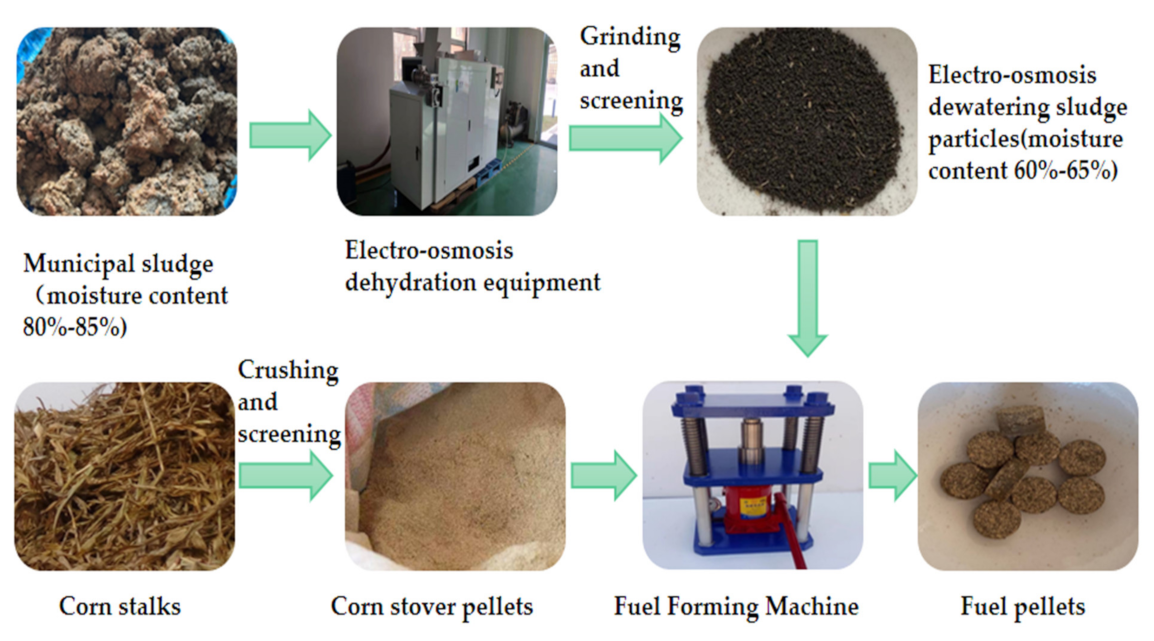
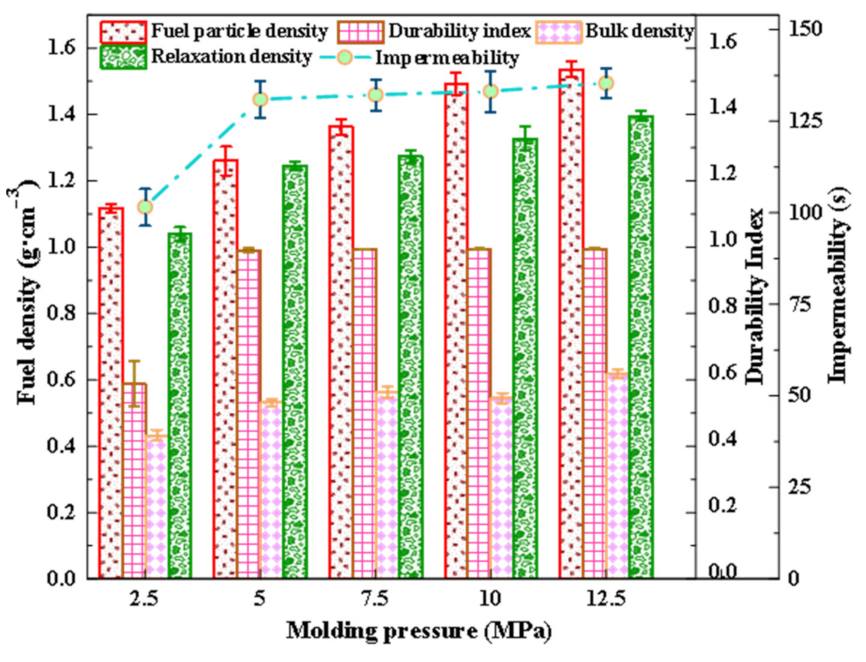

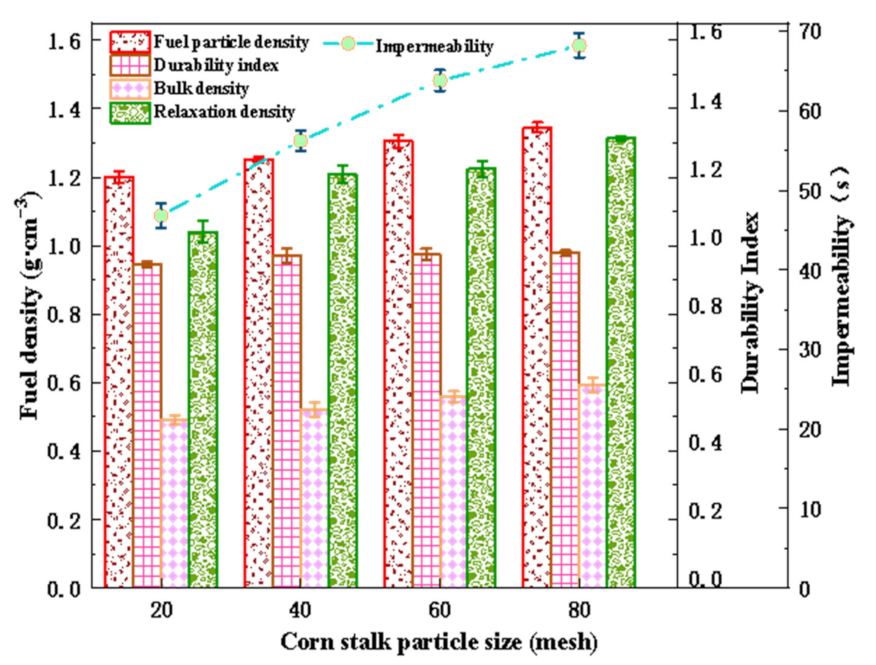
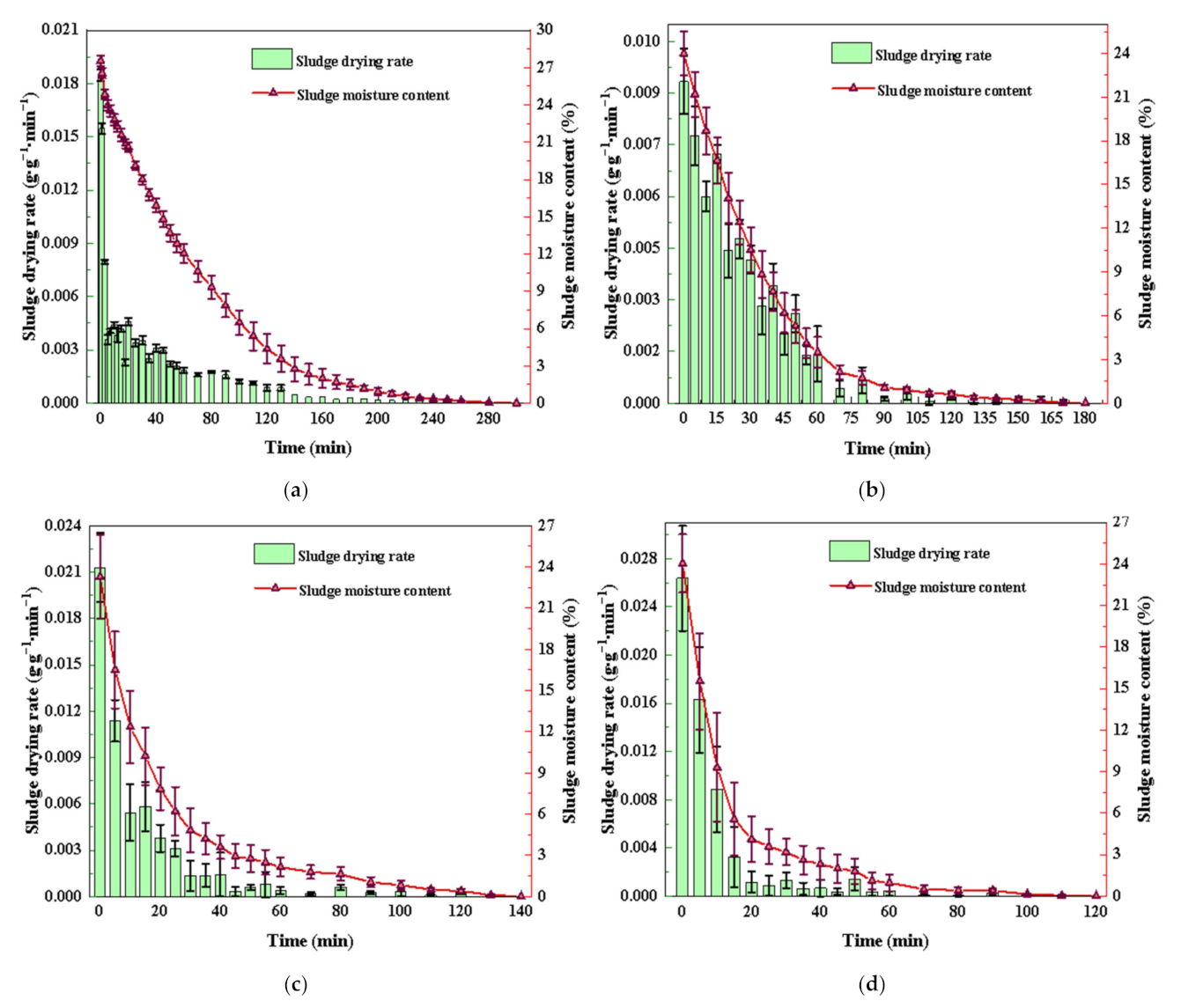

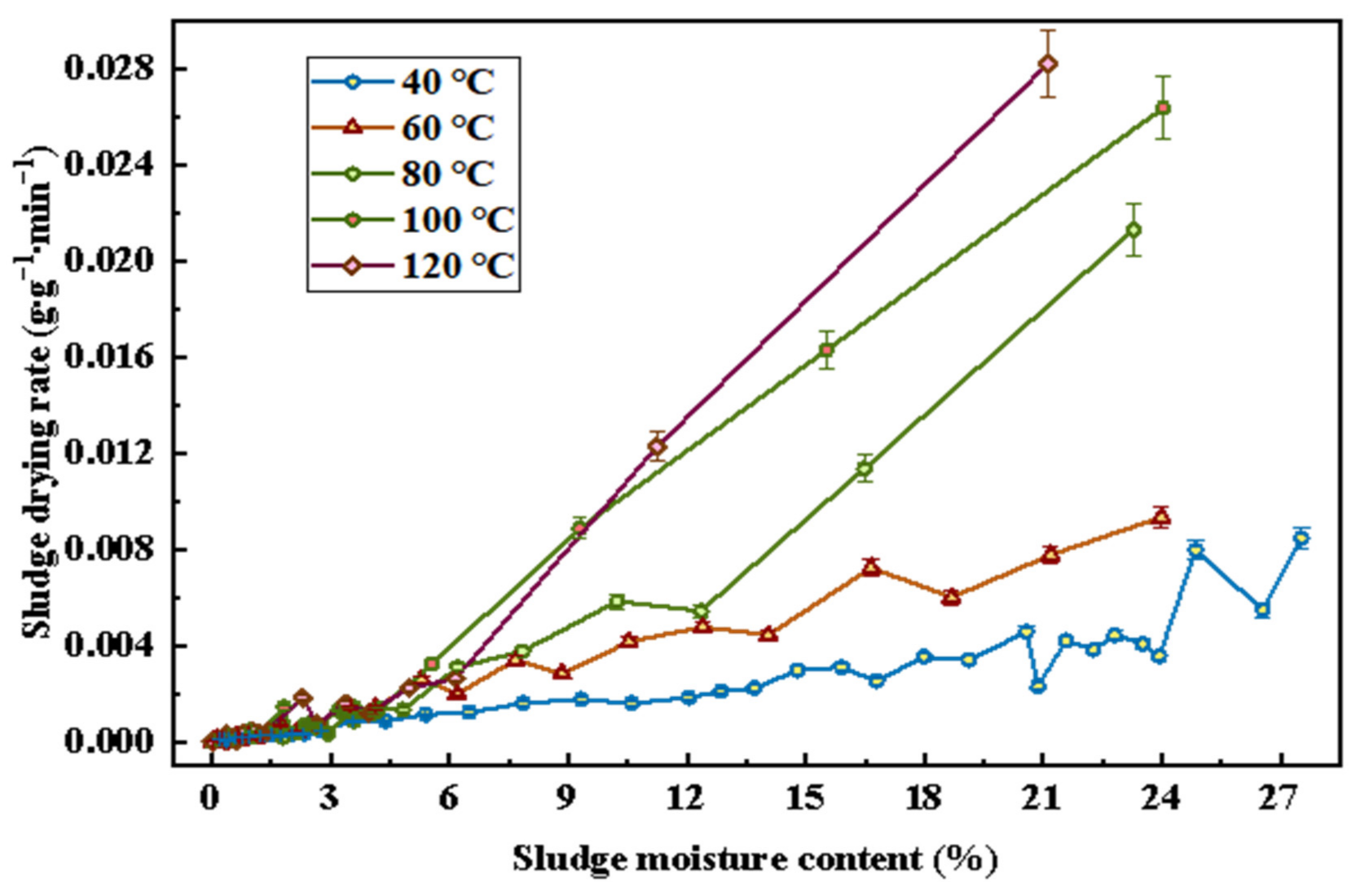
Publisher’s Note: MDPI stays neutral with regard to jurisdictional claims in published maps and institutional affiliations. |
© 2021 by the authors. Licensee MDPI, Basel, Switzerland. This article is an open access article distributed under the terms and conditions of the Creative Commons Attribution (CC BY) license (https://creativecommons.org/licenses/by/4.0/).
Share and Cite
Ma, L.; Sha, L.; Liu, X.; Zhang, S. Study of Molding and Drying Characteristics of Compressed Municipal Sludge-Corn Stalk Fuel Pellets. Energies 2021, 14, 3116. https://doi.org/10.3390/en14113116
Ma L, Sha L, Liu X, Zhang S. Study of Molding and Drying Characteristics of Compressed Municipal Sludge-Corn Stalk Fuel Pellets. Energies. 2021; 14(11):3116. https://doi.org/10.3390/en14113116
Chicago/Turabian StyleMa, Li, Li Sha, Xingxin Liu, and Shuting Zhang. 2021. "Study of Molding and Drying Characteristics of Compressed Municipal Sludge-Corn Stalk Fuel Pellets" Energies 14, no. 11: 3116. https://doi.org/10.3390/en14113116
APA StyleMa, L., Sha, L., Liu, X., & Zhang, S. (2021). Study of Molding and Drying Characteristics of Compressed Municipal Sludge-Corn Stalk Fuel Pellets. Energies, 14(11), 3116. https://doi.org/10.3390/en14113116





